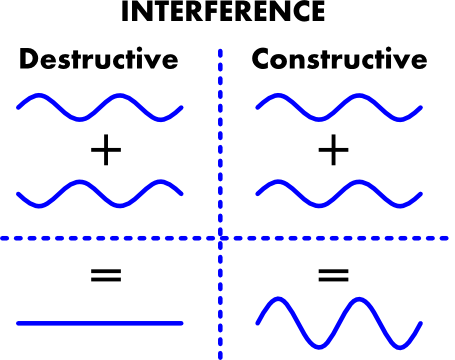
(Source)
The constructive waves are called in phase because their periods are the same and they line up perfectly with each other. The destructive waves, on the other hand, are called out of phase because they are shifted relative to each other. Because the waves are exactly half of a period out of phase, they cancel each other out and produce no sound. The interference caused by of out of phase sound waves creates what is known as phase cancellation.
Phase cancellation is an integral part of music technology, especially as most audio is recorded and mixed in stereo. When you have two speakers playing the left and right channels of a song, a slight offset in the sound produced by the speakers can result in phase cancellation, which ruins the sound reproduction. When recording an instrument in stereo, phase is an important consideration in regards to microphone placement. If microphones are set up such that they record the same sound, but at an offset in phase, the recording can be ruined.
It is clear that complete phase cancellation is something to be avoided in recording and mixing audio. However, like with distortion, phasing is often used in moderation as a desirable effect. By shifting the phase of the left and right channels of a sound with a phase effect, both constructive and destructive interference occur to different parts of the sound wave. The manipulated sound wave ends up with a distinct quality due to the unique filtering of the phase effect. This video illustrates the difference between a clean guitar sound and a guitar sound affected by a phase effect.
Works Cited:
No comments:
Post a Comment